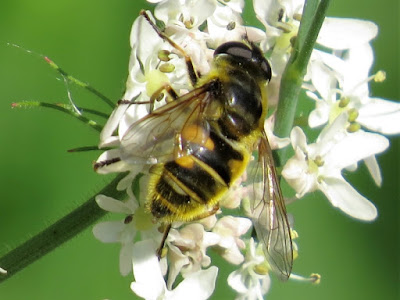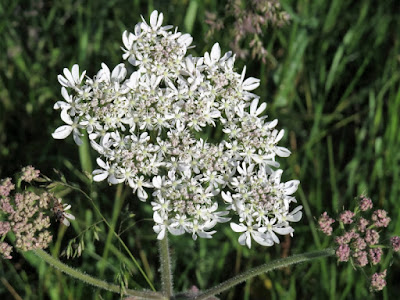9.0°C > 17.0°C: Areas of mainly thin high cloud only. Light SW breeze. Very good visibility.
Sunrise: 04:48 BST
* = a photo today
Priorslee Lake: 04:25 – 05:45 // 06:35 – 09:55
(113th visit of the year)
One that got away: a possible very distant and/or very high Curlew briefly heard at 05:35. Nothing seen. Not an impossible date to record a returning failed breeder – they were always back on the River Plym by 14th June when I spent much time in W Devon & SE Cornwall. In the absence of any visually confirmation and with only the briefest of call-notes I will let it pass.
Other bird notes:
- A Collared Dove made a rare appearance on the S side of Teece Drive, singing from trees in the Ricoh copse.
- The fly-over Black-headed Gull was my first record here sine 28 April.
- The three juvenile Coots were from the same now reasonably well-grown brood (#7?). More adults on the water might suggest that some second broods have failed.
- Several Great Crested Grebes seen in flight although there seemed to be just the three pairs.
Overhead:
- 2 Greylag Geese: duo outbound
- 17 Wood Pigeons
- 1 Common Buzzard
- 1 Black-headed Gull: age not determined
- 4 Lesser Black-backed Gulls: (near) adults
- 13 Cormorants: single, three duos, sextet
- 13 Jackdaws
- 15 Rooks
Hirundines etc., noted:
- 15 Swifts
- 1 Barn Swallow
- 2 House Martins
Warblers noted (the number in brackets is singing birds):
- 12 (12) Chiffchaffs
- 11 (10) Reed Warblers
- 14 (12) Blackcaps
- 4 (4) Garden Warblers
- 6 (3) Common Whitethroats
Count from the lake area
- 2 + 3 (1 brood) Canada Geese
- 2 + 5 (1 brood) Mute Swans
- 5 (5♂) Mallard again
- 2 (1♂) Tufted Duck, briefly
- 2 Moorhens
- 27 + 3 (1 brood) Coots
- 1 Lesser Black-backed Gull: immature, briefly
- 6 Great Crested Grebes
On / around the street lamps pre-dawn:
- 1 Tortrix moth (to be identified)
Noted later:
Butterflies / Moths:
- Common Nettle-tap (Anthophila fabriciana)
Bees / Wasps:
- Field Cuckoo Bumblebee (Bombus campestris)
- Early Bumblebee (Bombus pratorum)
Hoverflies:
- Two different Cheilosia sp.
- Marmalade Hoverfly (Episyrphus balteatus)
- Common Dronefly (Eristalis tenax)
- Chequered Hoverfly (Melanostoma scalare)
- Narcissus Bulb Fly (Merodon equestris)
- Parhelophilus sp.
- Long Hoverfly (Sphaerophoria scripta)
- Orange-belted Leafwalker (Xylota segnis)
Damselflies:
- Azure Damselfly (Coenagrion puella)
- Common Blue Damselfly (Enallagma cyathigerum)
- Blue-tailed Damselfly (Ischnura elegans)
Other Flies:
- Black Snipe fly (Chrysopilus cristatus)
- Snipe fly sp. (Rhagio scolopaceus?)
- Scorpion Fly (Panorpa sp.)
- Alder Fly (Sialis lutaria)
- Sawfly sp.
- Two different Tipula sps. craneflies
- Black Snipe fly (Chrysopilus cristatus)
- Snipe fly sp. (Rhagio scolopaceus?)
- Scorpion Fly (Panorpa sp.)
- Alder Fly (Sialis lutaria)
- Sawfly sp.
- Two different Tipula sps. craneflies
Bugs:
- Red-and-Black Froghopper (Cercopis vulnerata)
Beetles:
- 7 Spot Ladybird (Coccinella 7-punctata)
- Cardinal beetle Pyrochroa serraticornis
Spiders:
- Misumena vatia
- Stretch spider sp (Tetragnatha sp.)
- another spider to be identified
- Red-and-Black Froghopper (Cercopis vulnerata)
Beetles:
- 7 Spot Ladybird (Coccinella 7-punctata)
- Cardinal beetle Pyrochroa serraticornis
Spiders:
- Misumena vatia
- Stretch spider sp (Tetragnatha sp.)
- another spider to be identified
The sunrise coloured part of the sky.
A different vantage point
This Tortrix moth was on one of the lamp poles pre-sunrise. Bit pushed for time and one to ID later.
A largely dark bumblebee with faint white banding on the abdomen suggests Field Cuckoo Bumblebee (Bombus campestris)
I am fairly sure this is a Cheilosia sp. of hoverfly. The darkening in the wing provides only limited help it identifying the species of this very difficult group of largely black insects.
I think this is a different species of Cheilosia hoverfly. I am taking advice.
I showed Marmalade Hoverfly (Episyrphus balteatus) a few days ago. There was an item on BBC Radio 4 yesterday which told of many millions of this small hoverfly making it here from as far as North Africa each year. As well as being great pollinators the larvae prey on aphids. The programme reckoned trillions of aphids are eaten by the larvae each year.
A Common Dronefly (Eristalis tenax). Not a very common hoverfly at the moment.
Not a bumblebee – short antennae – this is a Narcissus Bulb Fly (Merodon equestris). A species of hoverfly.
My initial thought on this hoverfly was the common The Footballer (Helophilus pendulus). However it has less and fewer distinct lines on the thorax and looks more 'tubby'. It is one of the species Parhelophilus. There are three UK species and only males can be separated and then only by a better view of side of the insect.
My first Long Hoverfly (Sphaerophoria scripta) of the year. Only the males are 'long'
Also new for the year is this Orange-belted Leafwalker (Xylota segnis). A hoverfly for which I have cribbed the vernacular name from Stephen Falk's Flickr site.
A close view does not really help. Could it be that she has just emerged from the nymph stage and is still drying out? She did not seem inclined to fly away but I assumed that was because she was enjoying the meal.
An exciting-looking fly. One of the snipe flies, I think Rhagio scolopaceus.
One for more work later. There are several species of black and green sawflies. I may be able to work out which this is.
A good view of how the Swollen-thighed Beetle (Oedemera nobilis) got its name. Only the males have the swollen thighs.
I think this is a female. There are less common rather similar species.
One day I will get the angle right and be able to show the serrated antennae on this Cardinal beetle Pyrochroa serraticornis.
This crab spider Misumena vatia can change colour to match that of the flower it is hiding in. A bit vulnerable here!
Definitely one for the Shropshire Spider Recorder to help me with!
I am not at all sure what this is. I initially thought the detritus at the bottom right might be a spider and only then did I notice the insect It has very short wings and very long antennae. I am baffled
There have been a few of these Common Hogweed (Heracleum sphondylium) plants left-over from last year. This is the first 'new-season' plant I have seen in flower. Here looking down on the dense flat-topped heads with the outer petals significantly larger are all good ID features. When fully open will attract many insects.
I photographed a spike of Common Spotted-orchid (Dactylorhiza fuchsii) a few days ago before it opened. Here is one now beginning to open.
(Ed Wilson)
Between the lake and The Flash:
- Adult and juvenile Moorhens heard at the upper pool.
- No Moorhens seen or heard at the lower pool.
- Juvenile Long-tailed Tits seen.
- A Blackcap singing by the lower pool – first for several weeks.
(Ed Wilson)
------------------------------------------------------------------------------------------------------
Between the lake and The Flash:
- Adult and juvenile Moorhens heard at the upper pool.
- No Moorhens seen or heard at the lower pool.
- Juvenile Long-tailed Tits seen.
- A Blackcap singing by the lower pool – first for several weeks.
Also noted
- Common Pug (Eupithecia vulgata) on lamp pole alongside Wesley Brook
- Common Pug (Eupithecia vulgata) on lamp pole alongside Wesley Brook
This is one of those pesky 'pug' moths. As far as I can tell it is a Common Pug (Eupithecia vulgata) I found on lamp pole alongside the Wesley Brook.
(Ed Wilson)
The Flash: 05:50 – 06:30
(98th visit of the year)
Bird notes:
- Still just the two well-grown juvenile Coots from different broods. Some adults still sitting.
- Only one Great Crested Grebe located.
Birds noted flying over here:
- 7 Feral Pigeons
- 1 Herring Gull: immature
- 2 Starlings
Hirundines etc., noted:
- 15 Swifts
- 1 House Martin
Warblers noted (the number in brackets is singing birds):
- 3 (3) Chiffchaffs
- 3 (3) Blackcaps
On /around the water:
- 51 Canada Geese
- 1 Greylag Goose
- 3 + 2 (1 brood) Mute Swan
- 21 (17♂) Mallard
- 6 (4♂) Tufted Duck
- 3 Moorhens
- 2 juvenile (2 broods) Coot
- 1 Great Crested Grebe
Also noted
- Figure of Eighty moth (Tethea ocularis) on lamp pole in squirrel alley
I found this Figure of Eighty moth (Tethea ocularis) on lamp pole in squirrel alley. Not as clear as I would like – it was the tallest lamp pole and the camera flash would not reach, However the light was still rather poor in the alley. Nevertheless it is easy to see how it got its vernacular name.
(Ed Wilson)
(Ed Wilson)
------------------------------------------------------------------------------------------------------
The Flash: 05:50 – 06:30
(98th visit of the year)
Bird notes:
- Still just the two well-grown juvenile Coots from different broods. Some adults still sitting.
- Only one Great Crested Grebe located.
Birds noted flying over here:
- 7 Feral Pigeons
- 1 Herring Gull: immature
- 2 Starlings
Hirundines etc., noted:
- 15 Swifts
- 1 House Martin
Warblers noted (the number in brackets is singing birds):
- 3 (3) Chiffchaffs
- 3 (3) Blackcaps
On /around the water:
- 51 Canada Geese
- 1 Greylag Goose
- 3 + 2 (1 brood) Mute Swan
- 21 (17♂) Mallard
- 6 (4♂) Tufted Duck
- 3 Moorhens
- 2 juvenile (2 broods) Coot
- 1 Great Crested Grebe
Also noted
- Figure of Eighty moth (Tethea ocularis) on lamp pole in squirrel alley
I found this Figure of Eighty moth (Tethea ocularis) on lamp pole in squirrel alley. Not as clear as I would like – it was the tallest lamp pole and the camera flash would not reach, However the light was still rather poor in the alley. Nevertheless it is easy to see how it got its vernacular name.
(Ed Wilson)
------------------------------------------------------------------------------------------------------
On this day
2020
Priorslee Lake
Today's Sightings Here
2018
Priorslee Lake
Today's Sightings Here
2016
Priorslee Lake
Today's Sightings Here
2015
Local Area
Today's Sightings Here
2014
Local Area
Today's Sightings Here.
2013
Priorslee Lake
Great Spotted Woodpecker
Reed Warbler
Willow Tit.
(John Isherwood)
Redhill
Kestrel
Linnet
Stock Dove
Yellowhammer.
(John Isherwood)
2009
Priorslee Lake
9 Swifts
4 Chiffchaffs
(Ed Wilson)
2007
Priorslee Lake
Raven
(Ed Wilson)
2006
Priorslee Lake
4 Great Crested Grebes
1 Tufted Duck
2 Ruddy Duck
1 Kestrel
3 Stock Doves
4 Swift
2 Swallow
12 House Martin
7 Reed Warbler
2 Lesser Whitethroat
1 Common Whitethroat
1 Garden Warbler
10 Blackcaps
5 Chiffchaffs
2 Willow Tit
19 Magpies
8 Greenfinch
6 Reed Bunting
(Ed Wilson)

























